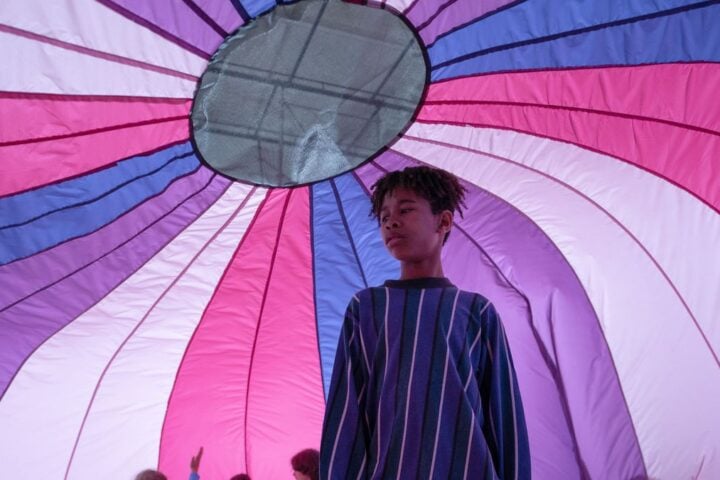Lucy Kerr’s vivisection of suburban naïveté, Family Portrait, opens with what could be a television advertisement for heart medication. Somewhere in Texas, late summer or early fall, a family meanders in a languid long take down to the riverbank to have their photograph taken for a Christmas card—three generations dressed in clean, bright clothes, flashing each other adoring smiles, the children weaving around the adults.
Except that this vision of togetherness, belonging, normality, comfort, is rendered unreal by the muted soundtrack, muddying the family’s dialogue past the point of intelligibility. As they all crowd into the frame, the adults corralling the children and forcing them into incongruous Santa hats, their voices become more distinct, and the scene abruptly cuts off. Not with the expected freeze frame of a camera flash, but before the family has struck a pose.
The rest of Family Portrait takes place at the family’s vacation house in the hours leading up to this opening scene, further chipping away at the idyll that it almost but doesn’t quite present. The film’s college-age protagonist, Katy (Deragh Campbell), and her Polish partner, Olek (Chris Galust), plan to catch a flight immediately after the picture is taken. As he and Katy aren’t married, he’s not allowed to appear in the picture, and so he’s asked to be the photographer. The pair spends the morning at the margins of unsettling conversations with the extended family, until Katy’s overbearing mother (Silvana Jakich) disappears. As Katy halfheartedly attempts to find her so they can get the photograph over with, the film takes a dogleg into the surreal.
Meanwhile, the unobtrusive camera gives a fly-on-the-wall glimpse at the real family lurking underneath its idea of itself: a craquelure of resentments and antagonisms that the portrait is intended to paper over. Through it all, the sound design, which overlaps dialogue in the mode of a Robert Altman film, imparts a sense of dread and unreality. During a consequential scene, two separate conversations take place in the same room simultaneously. In one, Olek tells Katy about a woman who falls in love with a lion. In the other, Katy’s sisters whisper about a cousin who’s died without warning or explanation. Like the sonic equivalent of deep focus, the scene obligates us to choose one conversation to pay attention to and miss the other.
In another, less-than-subtle conversation, Katy’s father (Robert Salas) tells Olek the story of an iconic photograph of her grandfather, taken in the Pacific theater during WWII. He describes how the backdrop was doctored to make it look like Vietnam and then printed onto T-shirts for sale. The story, told off-screen, makes it abundantly clear how easily photographs, which supposedly preserve shards of reality, can be altered to manipulate history.
By a logical extension, this scene ironizes the family portrait as propaganda for an ideal of the “American family.” Family Portrait comes across as bracingly skeptical of its own capacity—and that of film more generally—to correct for this distortion by stringing photographs together into a story, in this case by showing how near to the void one such American family teeters.
The point when Family Portrait descends into dream logic is signaled above all by amplified and mangled sound effects. As Katy returns to the vacation house after a swim in the river, we hear the almost deafening sound of a motor or generator, punctuated by the pocks of tennis rackets, quite some time before either of these objects appear on screen. This echoes the impression of menacing remoteness created by the soundtrack in the opening scene.
Family Portrait’s culminating scene is accompanied by its most disquieting, invasive sound: a train clattering over the rails, rendered almost unrecognizable and detached from what’s on screen, such that it may take place in entirely Katy’s head. An atmosphere of dread comes to permeate the film, a sense of implacable, alien forces encroaching on the foundations of the family structure from every angle, threatening to undermine it. Viruses, war, alligators, insects, mold, disappearances—all out of sight, but nonetheless audible, growing louder and louder.
If the edge of Kerr’s scalpel is blunted somewhat by the sheer number of other films that show the “dark underbelly of suburbia,” Family Portrait stands out for its profound mistrust, not just of images but of the sense of sight altogether. Set at the dawn of the Covid-19 pandemic, the film presents us with two endings, the one at the beginning, and another, darker ending that contradicts the first. As with the overlapping dialogue, we’re forced to choose. Seeing isn’t believing. Reality, Kerr suggests, may only be detectible with other senses.
Since 2001, we've brought you uncompromising, candid takes on the world of film, music, television, video games, theater, and more. Independently owned and operated publications like Slant have been hit hard in recent years, but we’re committed to keeping our content free and accessible—meaning no paywalls or fees.
If you like what we do, please consider subscribing to our Patreon or making a donation.


